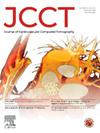冠脉钙化和心外膜脂肪组织CT钙评分扫描预测阻塞性冠状动脉疾病
IF 5.5
2区 医学
Q1 CARDIAC & CARDIOVASCULAR SYSTEMS
引用次数: 0
摘要
背景:低成本/无成本非对比CT钙评分(CTCS)检查可以提供冠状动脉粥样硬化的直接证据。在这项研究中,利用CTCS图像的特征,我们开发了一种新的机器学习模型来预测阻塞性冠状动脉疾病(CAD),由冠状动脉疾病报告和数据系统(CAD- rads)定义。方法:本研究分析了1324例接受CTCS和CT血管造影的苏格兰心脏试验患者。阻塞性CAD定义为CAD- rads 4A-5,非阻塞性CAD定义为CAD- rads 0-3。我们分析了临床、agatston评分和心外膜脂肪组学特征来预测阻塞性CAD。使用弹性网络逻辑回归选择最具预测性的特征并用于训练CatBoost模型。通过1000次重复的五倍交叉验证和生存分析来评估模型的性能,以预测主要不良心血管事件(MACE)和血运重建术。通过对2316例患者进行生存预测的外部验证集来评估通用性。结果:1324例患者中,334例(25.2%)诊断为阻塞性CAD。弹性网络回归确定了前14个特征(5个临床特征,2个agatston评分来源特征,7个脂肪组学特征)。该方法对阻塞性CAD的分类效果良好,AUC为90.1±0.9%,灵敏度/特异度/准确度为83.5±5.5% /93.7±1.9% /82.4±2.0%。纳入agatston评分衍生和脂肪组学特征显著提高了分类性能。生存分析显示,实际和预测的阻塞性CAD与经历MACE和血运重建术的患者有显著差异。结论:我们开发了一种新的机器学习模型,可以通过非对比CTCS扫描预测阻塞性CAD。我们的研究结果强调了CTCS成像在识别可能受益于高级成像的患者方面的潜在临床益处。本文章由计算机程序翻译,如有差异,请以英文原文为准。
Prediction of obstructive coronary artery disease using coronary calcification and epicardial adipose tissue assessments from CT calcium scoring scans
Background
Low-cost/no-cost non-contrast CT calcium scoring (CTCS) exams can provide direct evidence of coronary atherosclerosis. In this study, using features from CTCS images, we developed a novel machine learning model to predict obstructive coronary artery disease (CAD), as defined by the coronary artery disease-reporting and data system (CAD-RADS).
Methods
This study analyzed 1324 patients from the SCOT-HEART trial who underwent both CTCS and CT angiography. Obstructive CAD was defined as CAD-RADS 4A-5, while CAD-RADS 0–3 were considered non-obstructive CAD. We analyzed clinical, Agatston-score-derived, and epicardial fat-omics features to predict obstructive CAD. The most predictive features were selected using elastic net logistic regression and used to train a CatBoost model. Model performance was evaluated using 1000 repeated five-fold cross-validation and survival analyses to predict major adverse cardiovascular event (MACE) and revascularization. Generalizability was assessed using an external validation set of 2316 patients for survival predictions.
Results
Among the 1324 patients, obstructive CAD was identified in 334 patients (25.2 %). Elastic net regression identified the top 14 features (5 clinical, 2 Agatston-score-derived, and 7 fat-omics). The proposed method achieved excellent performance for classifying obstructive CAD, with an AUC of 90.1 ± 0.9 % and sensitivity/specificity/accuracy of 83.5 ± 5.5 %/93.7 ± 1.9 %/82.4 ± 2.0 %. The inclusion of Agatston-score-derived and fat-omics features significantly improved classification performance. Survival analyses showed that both actual and predicted obstructive CAD significantly differentiated patients who experienced MACE and revascularization.
Conclusions
We developed a novel machine learning model to predict obstructive CAD from non-contrast CTCS scans. Our findings highlight the potential clinical benefits of CTCS imaging in identifying patients likely to benefit from advanced imaging.
求助全文
通过发布文献求助,成功后即可免费获取论文全文。
去求助
来源期刊

Journal of Cardiovascular Computed Tomography
CARDIAC & CARDIOVASCULAR SYSTEMS-RADIOLOGY, NUCLEAR MEDICINE & MEDICAL IMAGING
CiteScore
7.50
自引率
14.80%
发文量
212
审稿时长
40 days
期刊介绍:
The Journal of Cardiovascular Computed Tomography is a unique peer-review journal that integrates the entire international cardiovascular CT community including cardiologist and radiologists, from basic to clinical academic researchers, to private practitioners, engineers, allied professionals, industry, and trainees, all of whom are vital and interdependent members of our cardiovascular imaging community across the world. The goal of the journal is to advance the field of cardiovascular CT as the leading cardiovascular CT journal, attracting seminal work in the field with rapid and timely dissemination in electronic and print media.
 求助内容:
求助内容: 应助结果提醒方式:
应助结果提醒方式:


